Are you wondering how to store leeks properly? Leeks are a key ingredient in many recipes, leading people to buy them in bulk. However, not everyone knows the best methods to keep leeks fresh. In this guide, I’ll explore everything you need to know about storing leeks safely and effectively.
First, you’ll understand leeks and how to pick the freshest ones for storage. Then, you’ll explore various long-term storage methods, including room temperature, fridge, and freezer options.
Additionally, I’ll discuss storing leeks with other fruits and vegetables, their shelf life, signs of spoilage, and the best ways to defrost frozen leeks. Finally, there are some highlighted dishes and beverages using leeks and cuisines that feature them.
Let’s dive in!
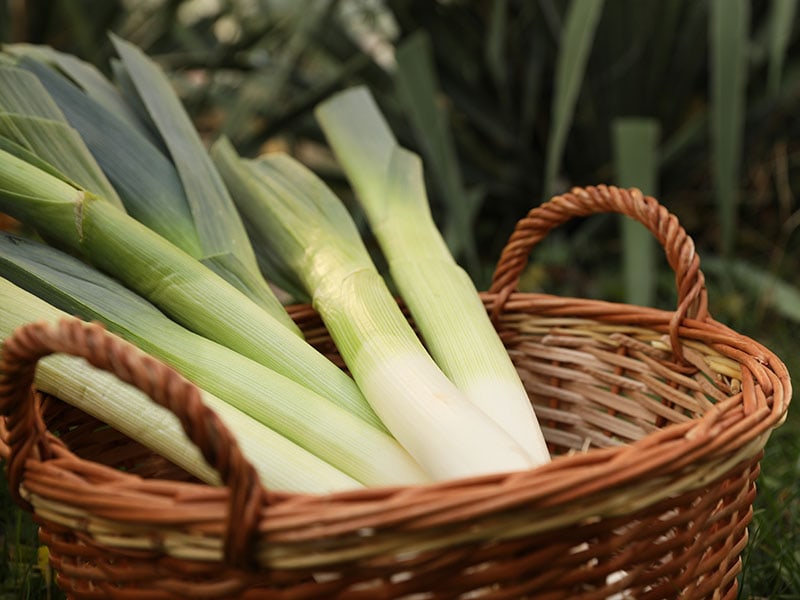
What Exactly Are Leeks?
Leek, an allium family member, resembles a giant green onion. Its mild, sweet flavor makes it versatile in various dishes and recipes. You can use leeks in soups, stews, and even salads.
When preparing leeks, cleaning them thoroughly is essential, as dirt can get trapped between their many layers.
Leeks are nutritious, offering a good source of vitamins A, C, and K and minerals like iron and manganese. They also contain fiber, which aids digestion.
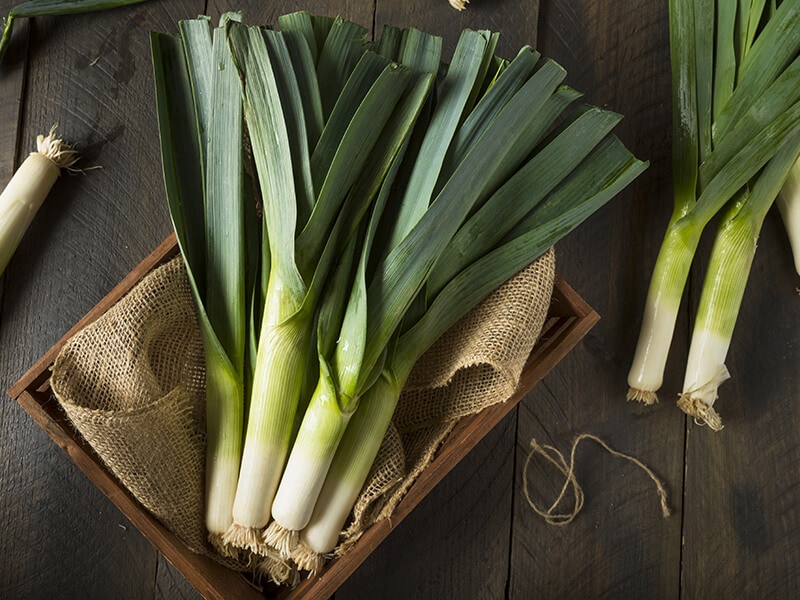
Now that you have decided to incorporate leeks into your daily diet, you need to know how to store them properly to retain their nutritional benefits and freshness in taste and texture. So, let’s start with some tips for selecting fresh leeks to store.
How To Pick Fresh Leeks For Storage?
To get the longest possible storage time, you should try to buy the best ones available. Here are what you should look for in fresh leeks.
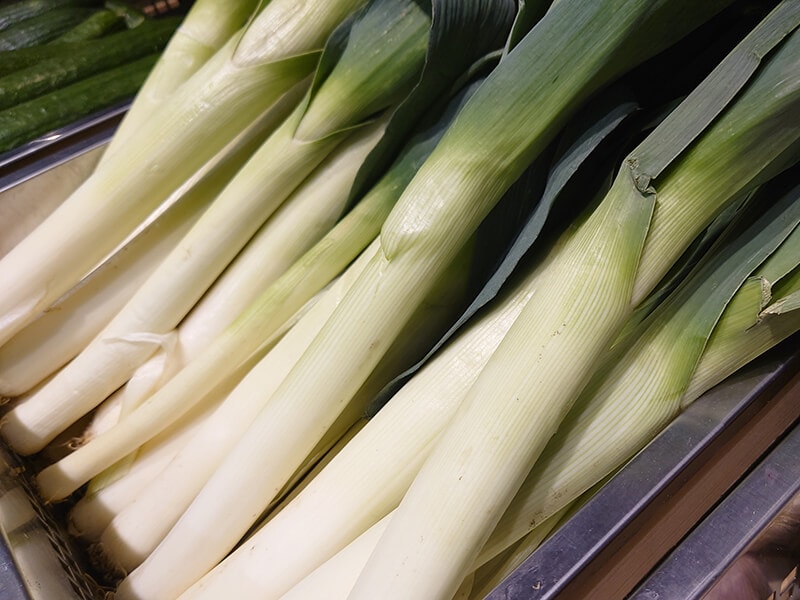
What Are Methods To Store Leek Long Term?
Here are 4 main ways to store leeks at home, depending on when and how you plan on using them. Each method and storage place has a different storage time, so choose the one that suits your needs the most.
1. Storing Leeks at Room Temperature
Room temperature storage is not ideal for leeks due to bacterial growth. However, if fridge space is limited, follow these steps to keep leeks fresh longer:
Storing Leek Seeds
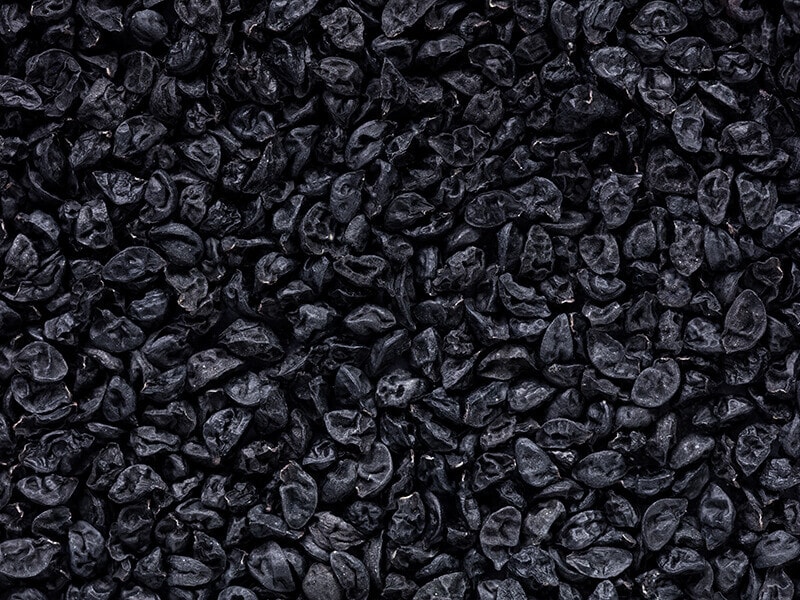
Leek seeds are pretty easy to store. Once cleaned, simply place them in a paper envelope. Remember to label the name and date so you won’t get them fixed up. Store the envelope in a cool, dark place. They will last 1-2 years this way.
Storing Leeks In Water
You can keep leeks fresh in water on your kitchen counter. Place the roots in a water-filled jar or container, ensuring the roots are fully submerged.
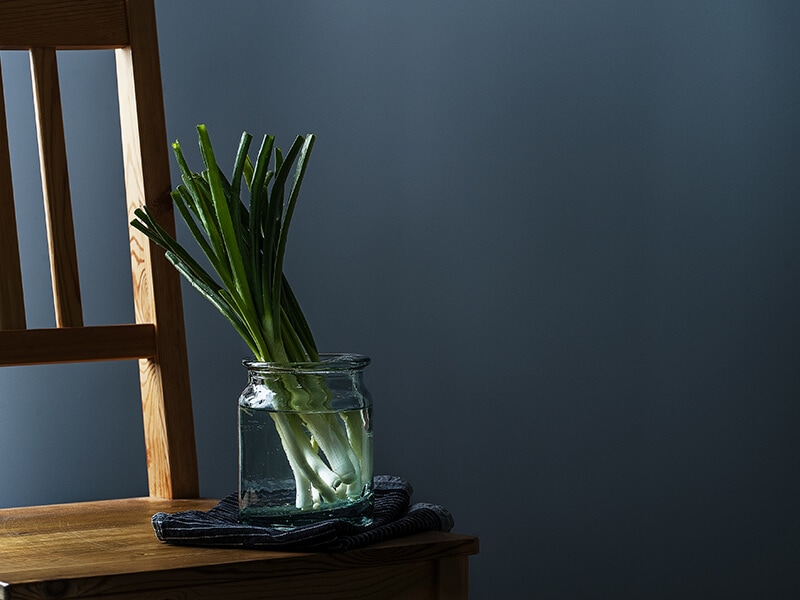
This method keeps leeks fresh for 1-2 days, depending on your location. So, you should only use this method if you plan to use them within a few days.
Storing Leeks in A Root Cellar
If you like growing your own vegetables, you will likely have a root cellar. Root cellars are not common in modern houses. However, if you have one, then that would be a perfect spot to store root vegetables like leeks.
Remember, do not wash your leeks before storing them. Make sure that their roots are still intact. Then, place leeks upright in a bucket or crate filled with 6-8 inches of damp soil. Keep the temperature at 32°F (0°C) to maintain freshness for 3-4 months. Avoid wetting the leaves.
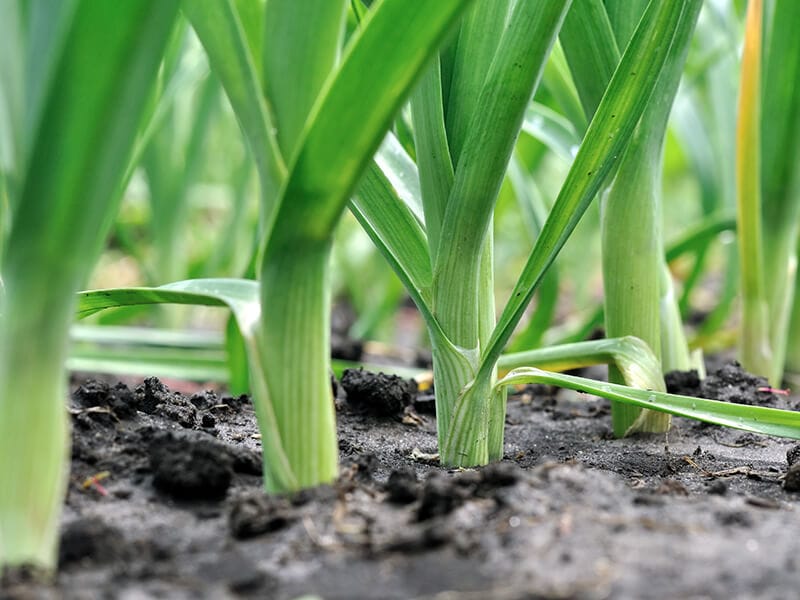
Storing Leeks in Sand
Sand storage is a great alternative for those without a root cellar. This method works in cool, dry places like basements, pantries, or garages.
The recommended sand for this method is “play sand” found at garden or home improvement stores. This type of sand has been washed, sieved, and dried, making it safe to use for food.
Start with filling any suitable container with 6-8 inches of damp sand. If it’s too dry, lightly spray it with water and toss it around with your hands to evenly distribute moisture.
Gently remove the dirt from the roots, but do not wash them. Plant them vertically in the sand just like how they grow, and ensure the leeks do not touch each other.
Maintain a cool temperature (ideally 32°F) and spray the sand occasionally to keep it moist. Check weekly for spoilage. This method keeps leeks fresh for up to 5 months.
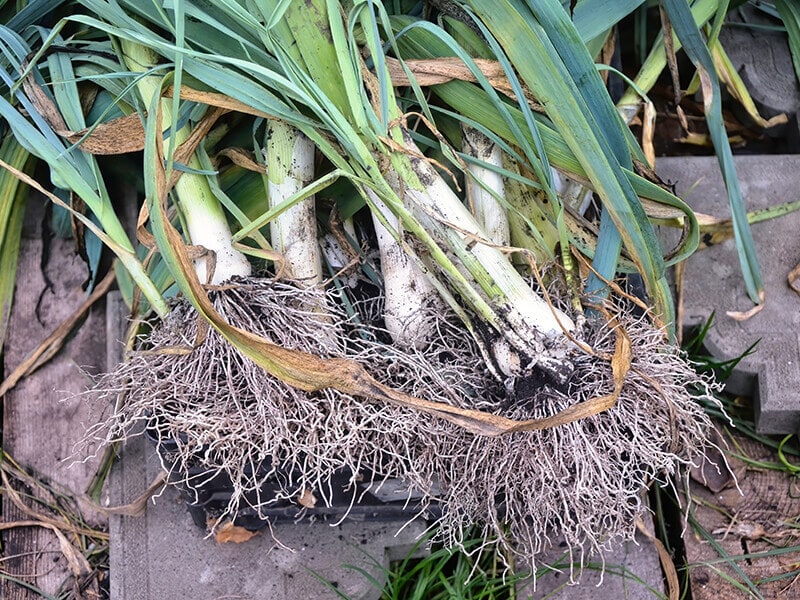
2. Storing Leeks In The Fridge
The fridge is your best friend when it comes to storing veggies. This is the easiest and most common way to store fresh, canned, or cooked leeks.
Fresh Leeks
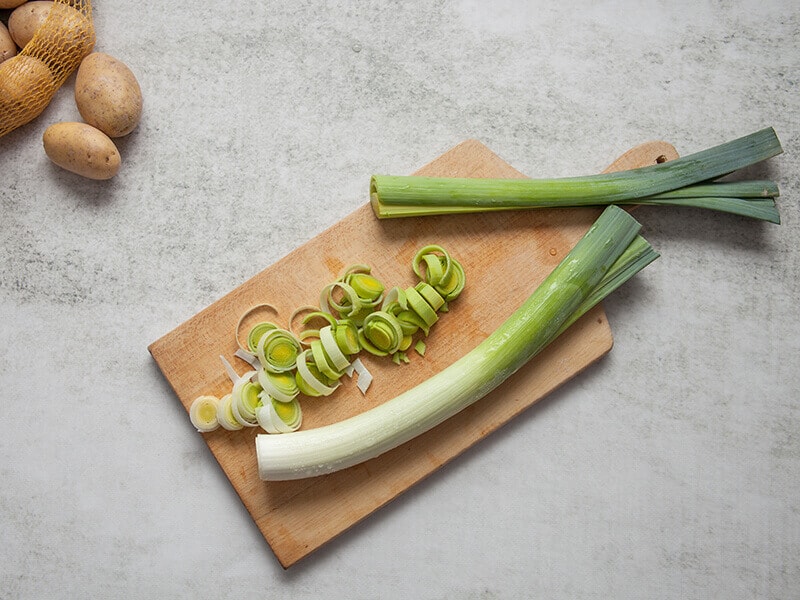
Do not wash or trim your leeks. If you spot any excess soil, just simply brush it off. Washing leeks exposes them to excess moisture, causing them to mold and spoil quickly.
Leeks can emit an odor that other foods may absorb in the refrigerator. To prevent this, store leeks in an airtight bag or container. If using a bag, wrap them loosely to retain moisture. Place the bag or container in the fridge’s crisper drawer.
Properly stored fresh leeks can last up to 2 weeks. Smaller leeks tend to last longer than larger ones.
Canned Leeks
You can extend leeks’ storage time from 2 weeks to 3 months by canning them in a mason jar
Clean thoroughly and cut the leeks into small slices. Boil a pot of water with a pinch of salt. Prepare a bowl of ice water. Blanch the leeks in boiling water for 30 seconds, then transfer them to the ice water bowl.
Drain and dry the leeks completely before placing them in a mason jar. In a saucepan, heat water, vinegar, salt, sugar, and spices (peppercorn, coriander seeds, red chili flakes, thyme). Once the sugar dissolves, pour the mixture into the mason jar with the leeks.
Let it cool entirely. After that, close the lid and store it in the fridge.
Cooked Leeks
Cooked leeks spoil easily, lasting only 2-3 days in the refrigerator. To avoid eating spoiled leftovers, label the container with the dish’s date. This way, you can track how long they have been stored.
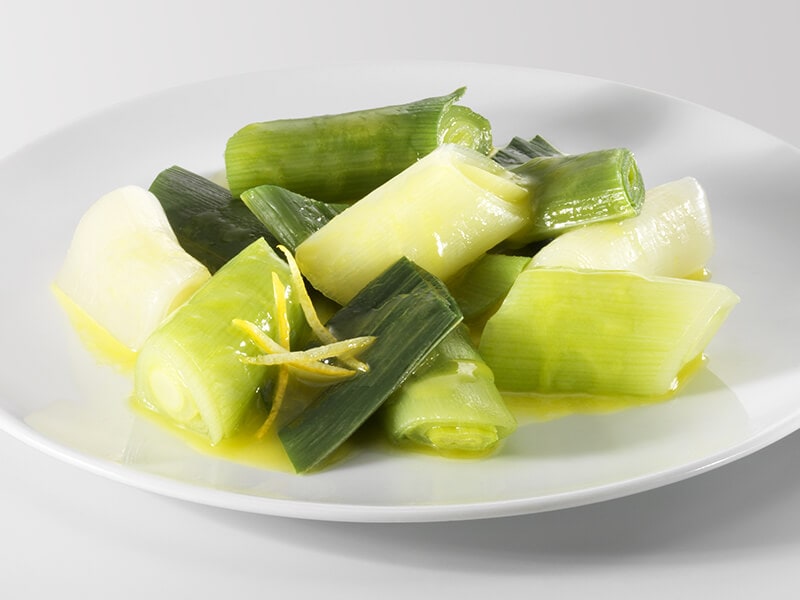
3. Storing Leeks in The Freezer
Freezing is an excellent way to extend leek storage time. This method is perfect for those with a garden full of leeks or a large bulk purchase.
Fresh Leeks
Fresh leeks, if prepared properly, can last up to 1 year, so if you have a lot of them, I recommend you follow these few steps:
Step 1: Clean Them
Unlike refrigerating, freezing leeks needs a bit of preparation. Cleaning them is the first thing you need to do.
Before washing, cut off the dark green tops and roots. The dark green tops can be used to flavor soups or stocks.
Wash the leeks thoroughly under running water, ensuring all layers are clean. Leeks tend to have dirt between layers due to their growth method.
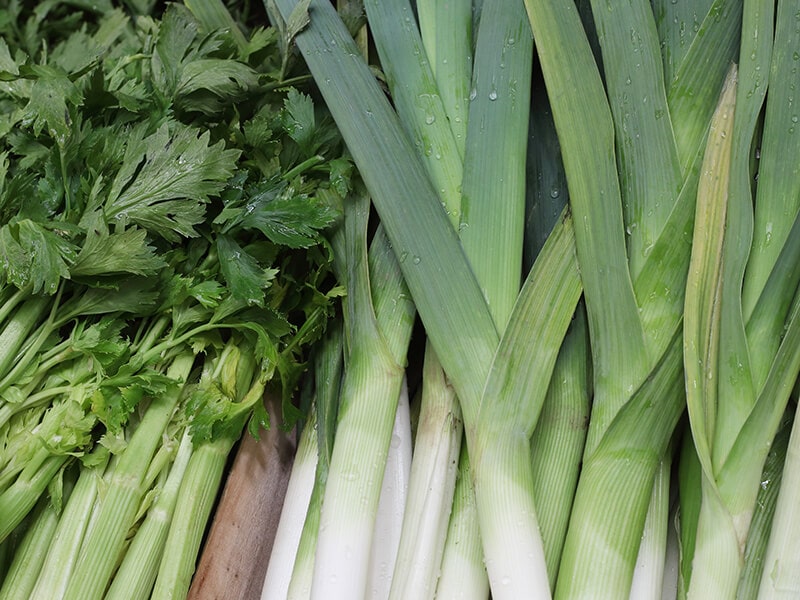
Step 2: Cut Them
Cut the leeks into the desired shape based on your planned dish. Freezing whole leeks is impractical, as they are difficult to store and defrost. Preparing them beforehand simplifies cooking.
If you have no specific dish in mind, halve them lengthwise and cut them into 2-3 pieces. Alternatively, thinly slicing them saves storage space. Rinse the leeks one last time to ensure no dirt remains.
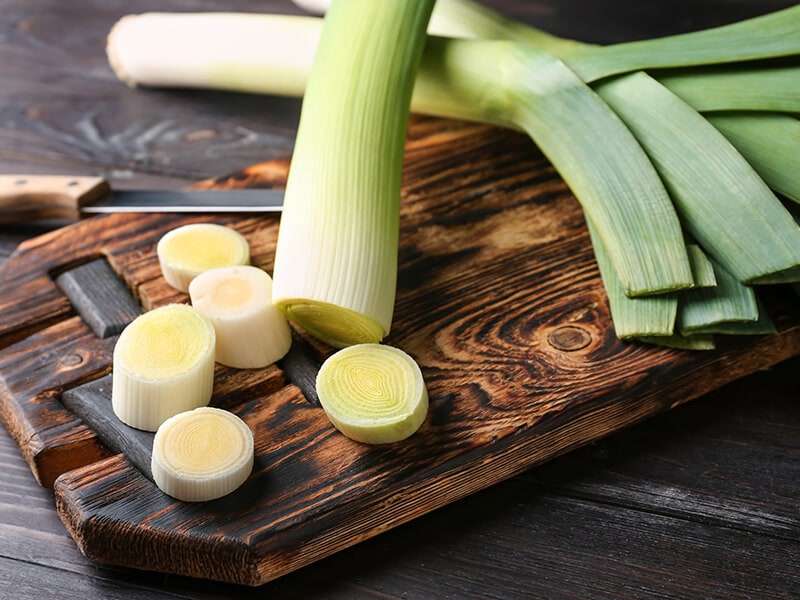
Take a look at a summary of how to clean and cut leeks!
Step 3: Blanch Them (Optional)
Take a step further and blanch your leeks before freezing. This helps them to maintain flavor, color, and freshness. You can skip this step; however, remember that they will only stay fresh for 2 months instead of 12.
Put the washed and cut leeks into a pot of boiling water for about 30 seconds to 1 minute. Meanwhile, prepare a pot of cold water. When done, remove the blanched leeks and immediately put them into the cold water.
Drain the leeks in a colander and let them dry completely. Speed up drying by laying them on a plate and patting them dry.
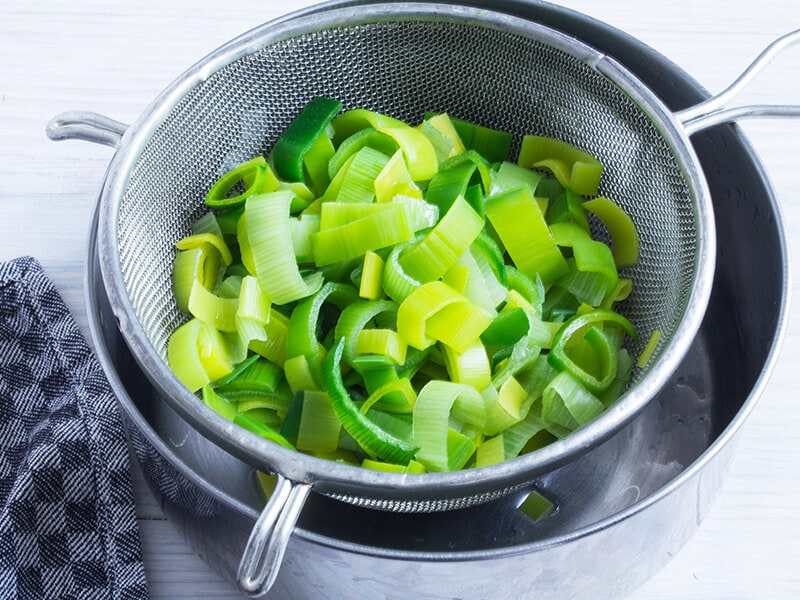
Freezing wet leeks reduces their storage life as well as taste. Make sure that your leeks are fully dried before moving on to the next step.
As you wait for your leeks to completely dry, you can process the throwaway leeks by putting them in a garbage disposal. Although there are differences between the continuous fiend and batch feed garbage disposal, these two types can process hard-leek pieces with little to no trouble.
Step 4: Freeze Them
Place the leeks one by one on a baking sheet lined with parchment paper. Freeze for 20-30 minutes, depending on the size of the pieces.
Frozen leeks should be hard and crisp. If soft, freeze them for a bit longer. Once fully frozen, transfer the leeks to a zipper storage bag or freezer-compatible container. Squeeze out any air before sealing tightly. Store in the freezer for up to 1 year.
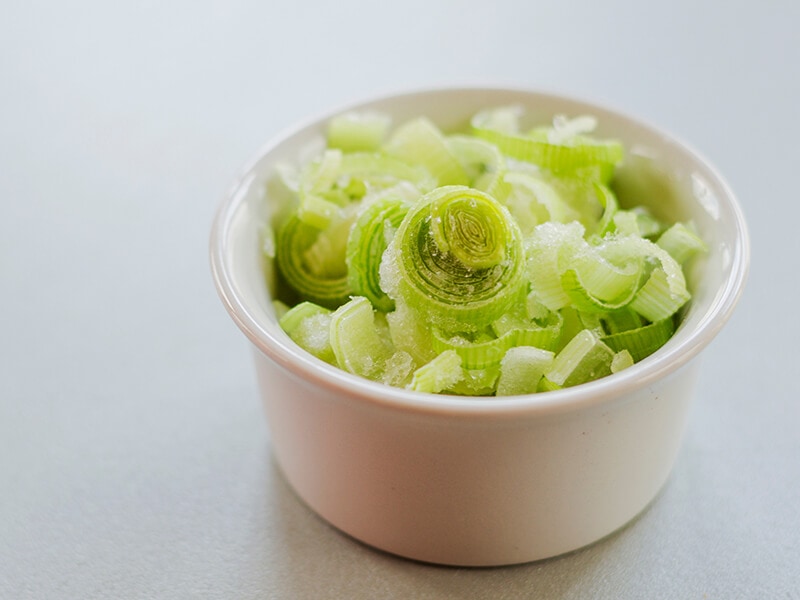
For lively step-by-step instructions, take a look!
Making Leek Purée
If you plan on using the leeks to flavor soup and stock, you can purée them before freezing.
After blanching the leeks as you do in step 3, take them out and put them in a blender or food processor based on your preferences. There’s no need to dry them.
Add some extra-virgin olive oil to have a smooth consistency. Once nicely blended, pour it into an ice tray and put it in the freezer until frozen.
You can leave them like so or pop them out and store them in a storage bag or container in the freezer. And done, you have had your very own tiny cubes of flavor.
If you don’t have an ice tray, you can freeze the purée directly in a container. However, unless you plan to use all of it at once, you will need to thaw the entire container and scoop out what you need. Refreezing the purée can make it watery and less flavorful.
4. Dehydrating Leeks
Using a dehydrator is a fantastic way to extend the shelf life of leeks. This method also works well for banana peppers, jalapenos, basil, onions, garlic, and various other foods.
First, clean and cut the leeks following the earlier instructions. Spread the leeks evenly on the dehydrator sheet. Set the dehydrator to 135°F and leave them for about six hours or until they become crispy.
You’ll know the leeks are ready when they easily crumble in your hand or crack crisply when bent. If the leeks are still soft, continue drying them.
Once done, let the leeks cool and store them in an airtight container.
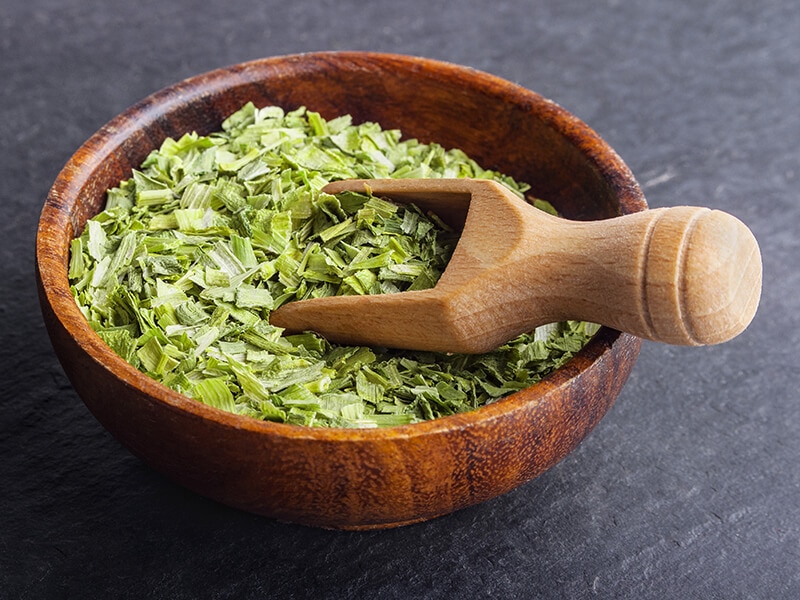
You can dehydrate leeks using a regular oven if you don’t have a dehydrator. Remember to set your oven to the lowest temperature to prevent charring. Spread the cleaned and cut leeks on a baking sheet. Bake for a few hours, checking regularly. Rotate the leeks as needed to ensure even drying.
Dehydrated leeks will last for up to 1 year when stored in an airtight container.
Can Leeks Be Stored with Other Fruits and Vegetables?
Here are some tips on how to store leeks with other fruit varieties and other vegetables:
1. Separate Ethylene-Producing Fruits
Leeks should be kept away from ethylene-producing fruits like apples, bananas, and tomatoes or veggies like carrots, celery, and leafy greens. Ethylene gas can speed up the ripening and spoilage of vegetables, including leeks.
2. Use Proper Storage Containers
To keep leeks fresh, store them in perforated plastic bags or reusable produce bags. This helps maintain humidity while allowing some airflow, preventing them from becoming slimy.
3. Avoid Strong-Smelling Vegetables
Leeks can absorb odors from strong-smelling vegetables like onions and garlic. It’s best to store them separately to maintain their mild flavor.
So, what is the shelf life of leek in different conditions? Check out the next part for more details.
How Long Do Leeks Last?
Depending on how you prepare and store it, the answer may vary. Take a look at this chart to learn more about the storage time of each method.
| In | Cooked Leeks | Fresh Leeks |
|---|---|---|
| Pantry | Not recommended | 1-2 days |
| Fridge | 2-3 days | Up to 2 weeks |
| Freezer | 2 months | Up to 1 year (blanched) |
| Root Cellar | Not recommended | 4 months |
| Sand | Not recommended | 5 months |
Additionally, leeks stored in mason jars will last 3 months. Dehydrating the leeks is as effective as freezing, they will last 1 year this way. Next, let’s check out some spoilage signs of this veggie.
What Are Signs To Tell That Leeks Are Spoiled?
There are 5 main signs of spoilage of fresh leeks. Remember these few tips to know how to deal with them.
What Are Ways To Defrost Frozen Leeks?
Here are the 4 best methods to defrost frozen leeks.
- Placing Leeks on the Kitchen Counter: Leave them on the counter for 30 minutes to 1 hour to defrost completely.
- Using Running Water: Place the vegetables under running water for a few minutes until they become less hard, which speeds up defrosting.
- Using Microwave: Use the microwave’s defrost function for 1 to 2 minutes. Be cautious not to leave them too long, as they can become mushy.
- Cooking Leeks with Other Foods: Add them directly to the cooking dish. The heat from the cooking process will quickly thaw them with little to no loss in flavor or texture.
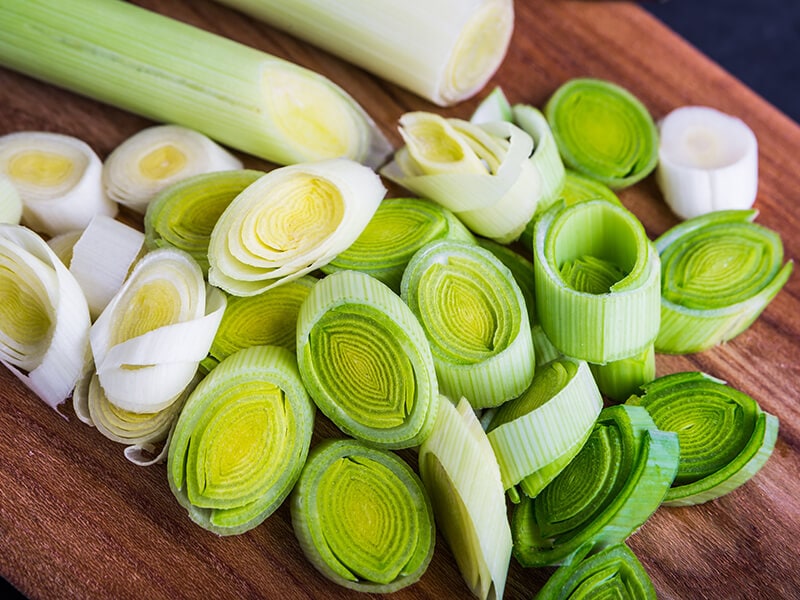
What Are Popular Dishes and Beverages Using Leeks?
Here are some popular examples of using leeks as an ingredient in many delicacies and drinks around the world.
- Dishes: Leeks are ideal for making soups, tarts, quiches, risotto, and more.
Examples: Leek and potato soup, vichyssoise, cock-a-Leekie soup, leek tart, leek and mushroom risotto, leek and cheese quiche, etc.
- Beverages: This veggie is typically paired with other fruits (e.g., apple, lemon, cucumber) or vegetables (e.g., kale, spinach, beet) to make smoothies or juices.
Examples: Smoothies or juices with leeks.
Next, I’ll introduce some cuisines in the world that usually use leek in their delights.
Which Cuisines Commonly Feature Leeks?
Below are 3 cuisines that widely consume leeks in their recipes.
- French Cuisine: Often uses leeks in French-style delights like Flamiche aux Poireaux (a quiche made of leek, cheese, and cream) and soups, like Pot-Au-Feu.
- Scottish Cuisine: Incorporates leeks in traditional Scottish dishes, ideally Cock-a-Leekie soup, emphasizing their role in comforting soups.
- British Cuisine: Features leeks in hearty British delicacies, ideally soups or stews, like cawl.
Lastly, with all the storage methods I provided in this article, I hope to inspire you to include leeks into your daily diet. If you find these tips helpful, remember to like and share this article. And if you have any more questions about this topic, feel free to comment them down below.
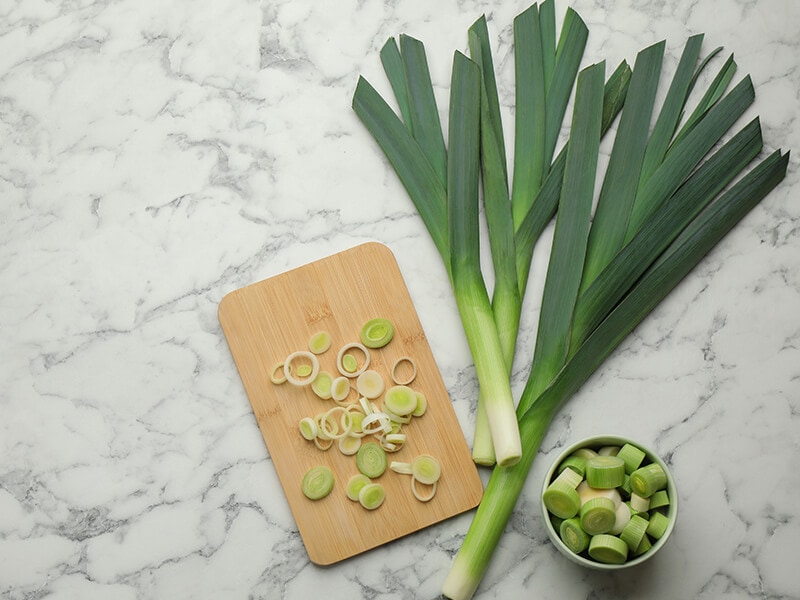
How To Store Leeks
Equipment
- Container
- Baking tray
- Parchment Paper
- Glass Jar
- Dehydrator
- Zipper Bag
Ingredients
- Fresh leeks
- Water
- Iced water
- Seasonings: Vinegar, salt, sugar
- Spices: Peppercorn, coriander seeds, red chili flakes, thyme
Instructions
At Room Temperature
- Fill a jar with water. Place the leek (root submerged in water) inside the jar. Store in a cool and dry place.
In The Fridge
- Brush off (do not wash) any dirt or soil. Put the leeks in a storage bag. Tight the bag loosely.Place them in the crisper drawer.
In The Freezer
- Cut off the dark green tops and the roots. Wash the leeks under running water. Cut them into desired sizes.
- Blanch the leeks for 30 seconds to 1 minute. Transfer them into an ice bath.Drain and wait for the leeks to dry completely.
- Arrange the leeks on a lined baking sheet. Flash freeze for about 30 minutes.Transfer them into a zipper storage bag or freezer-safe container.
- Freeze the leeks.
Canning The Leeks
- Clean and cut the leeks into small slices.Fill a pot with water and a pinch of salt. Bring to a boil. Prepare a bowl of ice water. Blanch the leeks for 30 seconds. Transfer them to the ice bath.
- Drain, let dry, and put into a Mason jar.
- Heat some water, vinegar, salt, sugar, and other spices in a saucepan until the sugar dissolves.
- Pour the mixture into the jar, wait for it to cool, then close the lid. Store in the fridge.
Notes
- After blanching the leeks, make sure that they are completely dry before freezing them.
- If you plan on using the leeks to flavor soup and stock, you can purée them, then freeze them.
- You don’t usually need to defrost your leeks as the heat from cooking should be enough to reheat them. However, if you use leeks to garnish, put them on the kitchen counter and wait for 30 minutes to 1 hour.
- Be aware of spoilage signs, such as yellow parts, odd smells, slimy skin, or mold.
Nutrition
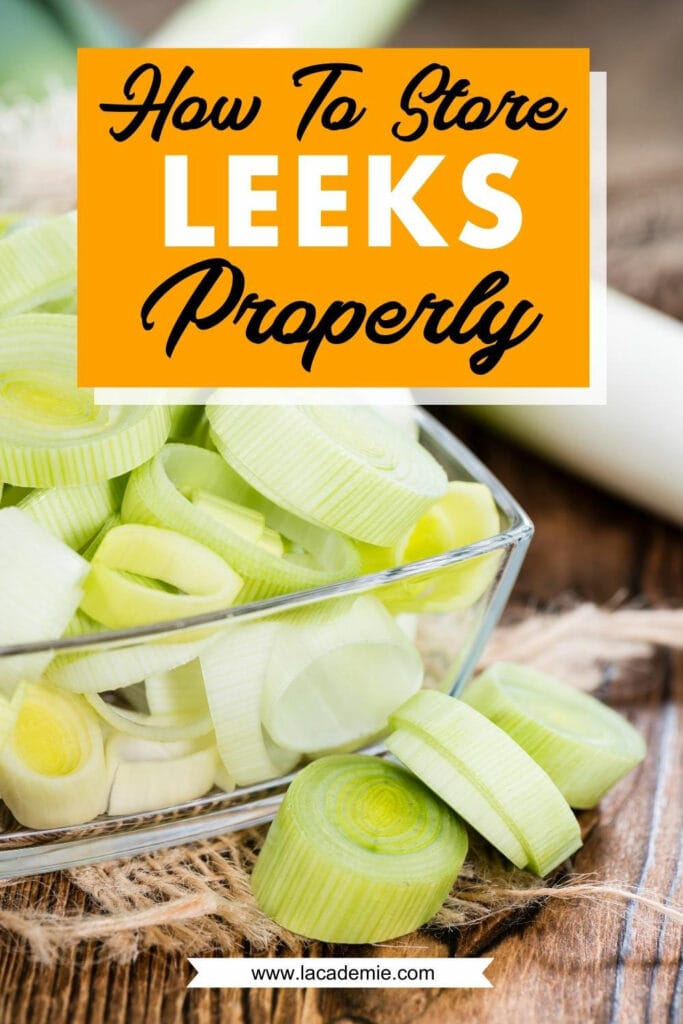


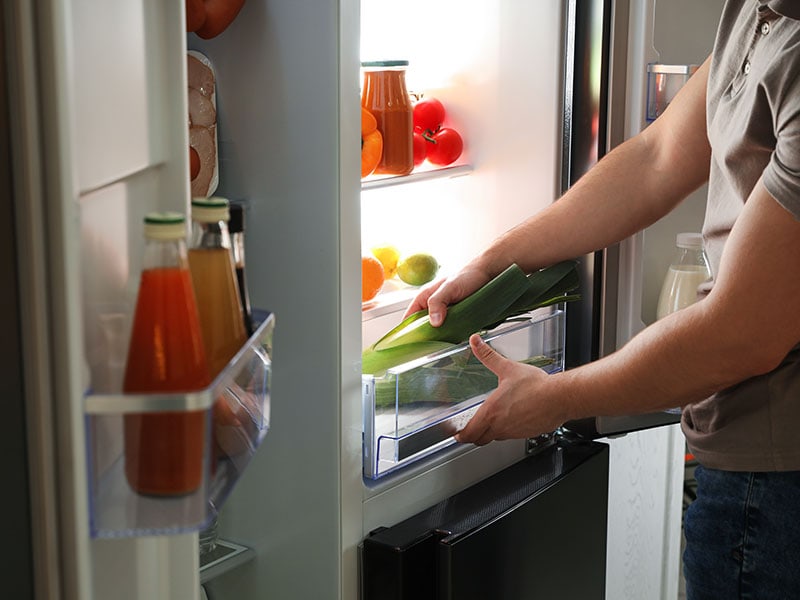
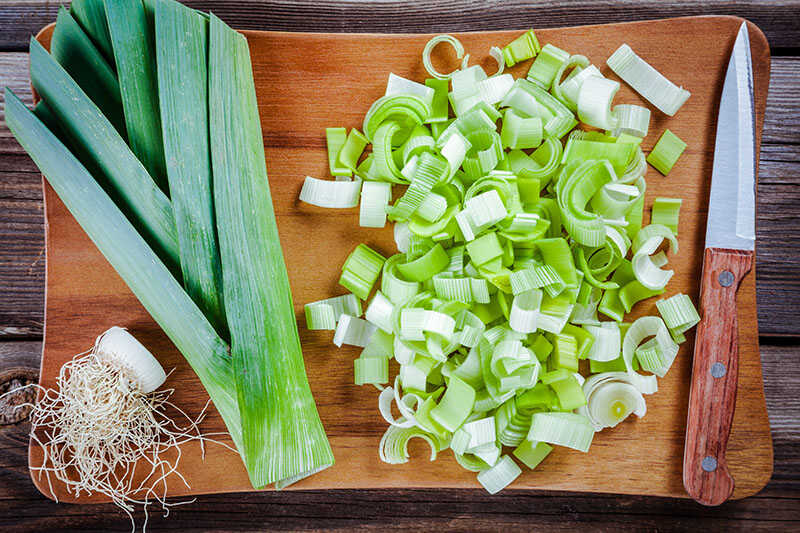
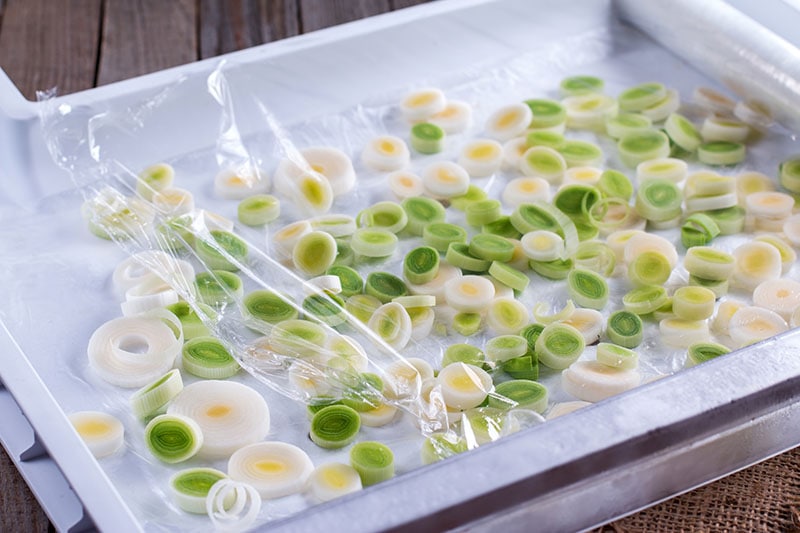
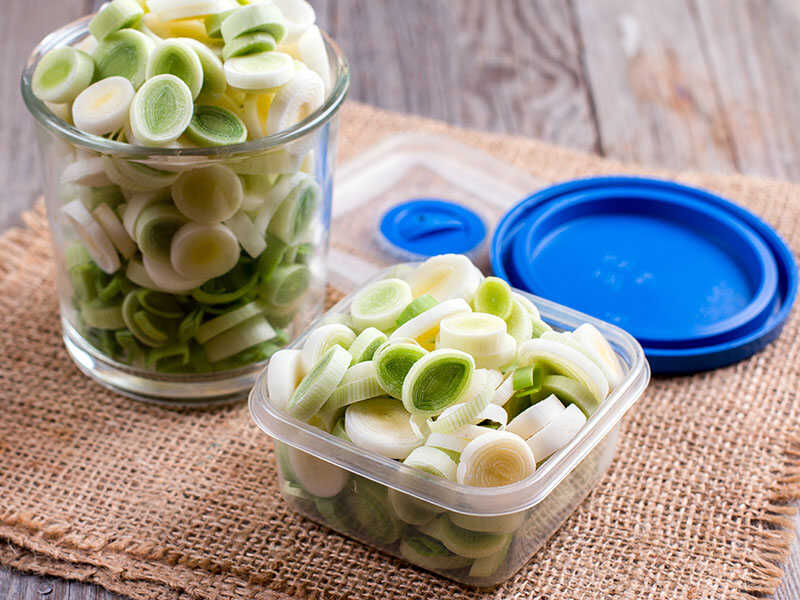
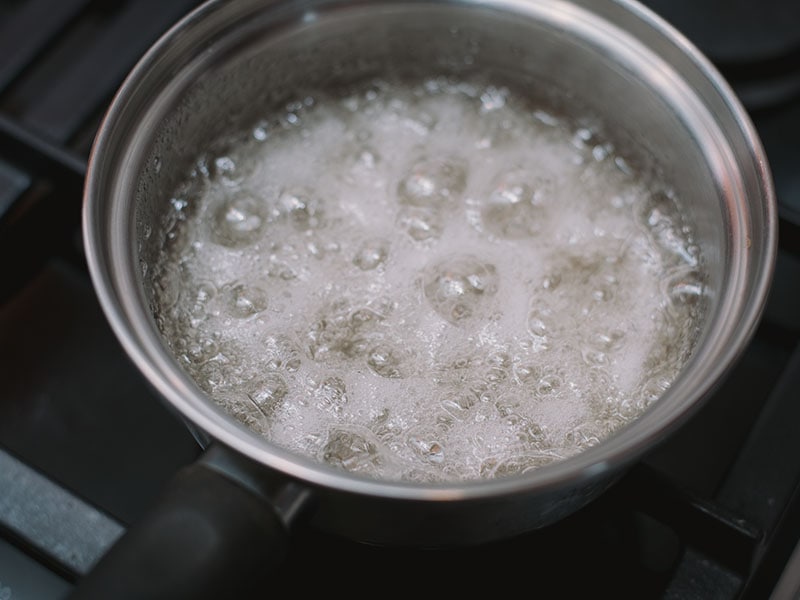
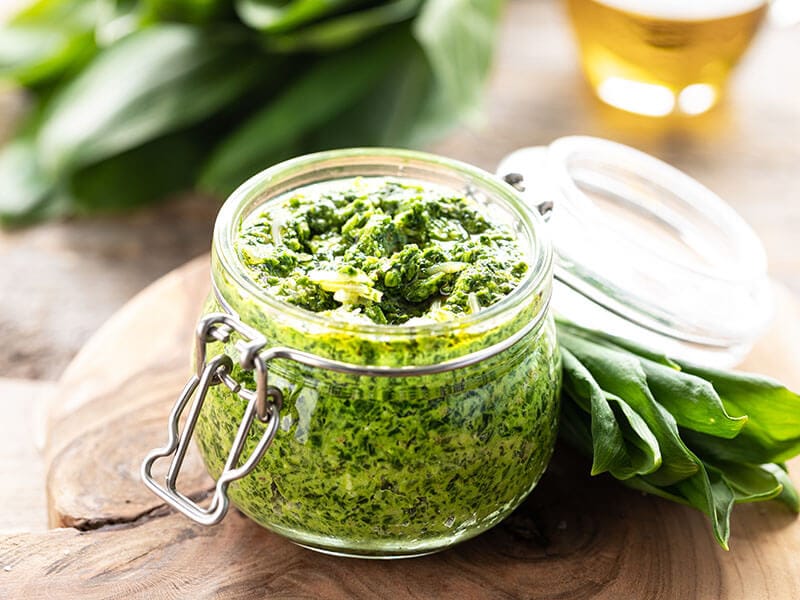

Jamie Scott
Editor in Chief, Senior Content Writer
Expertise
Home Cooking, Meal Planning, Recipe Development, Baking and Pastry, Food Editor, Cooking-video Maker, Western Food Evaluation Expert
Education
Le Cordon Bleu College of Culinary Arts
Local Community College, New York, NY
Jamie Scott is a skilled culinary expert and content creator specializing in Western cuisine. With over 15 years in the culinary field and formal training from Le Cordon Bleu, Paris, Jamie deeply understands how to blend nutrition with delicious flavors. His passion for cooking matches his commitment to making healthy eating accessible and enjoyable.
On Fifteen.net, Jamie brings a fresh perspective to classic dishes and beverages, offering readers insightful recipes, cooking tips, and a fresh view on meal planning that emphasizes taste, health, and simplicity.